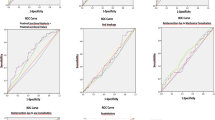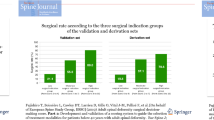Abstract
Study Design
Multicenter, prospective study of consecutive adult spinal deformity (ASD) patients.
Objective
To Validate Schwab’s classification accuracy for surgical indication, and to evaluate a simplified sagittal modifier.
Summary of Background Data
The SRS-Schwab Radiologic Classification based on clinical impact parameters, offers 27 different sagittal classification possibilities regarding sagittal vertical alignment (SVA), pelvic tilt (PT), and pelvic incidence—lumbar lordosis (PILL). The high number of classification possibilities makes it complex to use.
Methods
Inclusion criteria were ASD patients, presenting at least 1 criteria: Cobb ≥ 20°, SVA ≥ 5 cm, thoracic kyphosis ≥ 60°, or PT ≥ 25°. A total of 1,004 patients (410 nonoperative and 594 operative) were classified regarding SVA, PT, and PI-LL (0, +, ++), and 27 possibilities were identified. Categories were formed by adding the number of + signs, considering PT, SVA, and PI-LL. Three specific categories were identified: Aligned: 0 +; Moderate deformity: 1 to 3+; and Severe deformity: 4 to 6+. A χ-square test was performed for surgical indication (operated or not) and an analysis of variance was performed to evaluate the relationship between categories and Oswestry Disability Index (ODI). Probability <.05 was considered significant.
Results
Significant differences for HRQoL scores and surgical indication were found in the 27 sagittal parameter possibilities. For nonoperative patients, 230 (56.1%) were classified as aligned, 145 (35.4%) as moderate, and 35 (8.5%) as severe. For operative patients, there were 200 (33.7%), 215 (36.2%), and 179 (30.1%) in each respective subgroup. For HRQoL scores and surgical indication, no significant differences were found within each category, but significant differences were found when comparing the subgroups.
Conclusions
Despite the correlation between SRS-Schwab classification and surgical indication, it is complex to use, with a total of 27 possibilities regarding sagittal modifiers. This simplification into three categories offers more readability, without losing any significant information, and could replace Schwab sagittal modifiers. In association with other parameters, they could be used for decision-making.
Level of Evidence
Level II.
Similar content being viewed by others
References
Terran J, Schwab F, Shaffrey CI, et al. The SRS-Schwab adult spinal deformity classification: assessment and clinical correlations based on a prospective operative and nonoperative cohort. Neurosurgery 2013;73:559–68.
Ponseti IV, Friedman B. Prognosis in idiopathic scoliosis. J Bone Joint Surg Am 1950;32:381–95.
King HA, Moe JH, Bradford DS, et al. The selection of fusion levels in thoracic idiopathic scoliosis. J Bone Joint Surg Am 1983;65: 1302–13.
Lenke LG, Betz RR, Harms J, et al. Adolescent idiopathic scoliosis: a new classification to determine extent of spinal arthrodesis. J Bone Joint Surg Am 2001;83:1169–81.
Schwab F, Farcy JP, Bridwell K, et al. A clinical impact classification of scoliosis in the adult. Spine (Phila Pa 1976) 2006;31:2109–14.
Neuman BJ, Baldus C, Zebala LP, et al. Patient factors that influence decision making: randomization versus observational nonoperative versus observational operative treatment for Adult symptomatic lumbar scoliosis. Spine (Phila Pa 1976) 2016;41:E349–58.
Schwab F, Ungar B, Blondel B, et al. Scoliosis Research Society-Schwab adult spinal deformity classification: a validation study Spine (Phila Pa 1976) 2012;37:1077–82.
Smith JS, Klineberg E, Schwab F, et al. Change in classification grade by the SRS-Schwab Adult Spinal Deformity Classification predicts impact on health-related quality of life measures: prospective analysis of operative and nonoperative treatment. Spine (Phila Pa 1976) 2013;38:1663–71.
Glassman SD, Bridwell K, Dimar JR, et al. The impact of positive sagittal balance in adult spinal deformity. Spine (Phila Pa 1976) 2005;30:2024–9.
Djurasovic M, Glassman SD. Correlation of radiographic and clinical findings in spinal deformities. Neurosurg Clin N Am 2007;18:223–7.
Wang G, Hu J, Liu X, et al. Surgical treatments for degenerative lumbar scoliosis: a meta analysis. Eur Spine J 2015;24:1792–9.
Smith JS, Shaffrey CI, Lafage V, et al. Comparison of best versus worst clinical outcomes for adult spinal deformity surgery: a retrospective review of a prospectively collected, multicenter database with 2-year follow-up. J Neurosurg Spine 2015;23:349–59.
Boissiere L, Vital J, Challier V, et al. Global tilt and lumbar lordosis index: two parameters to understand positive balance analysis. Eur Spine J 2015;24(suppl 6):669–710.
Barrey C, Roussouly P, Le Huec JC, et al. Compensatory mechanisms contributing to keep the sagittal balance of the spine. Eur Spine J 2013;22(suppl 6):834–41.
Hallager DW, Hansen LV, Dragsted CR, et al. A comprehensive analysis of the SRS-Schwab Adult Spinal Deformity Classification and confounding variables—a prospective, non-US cross-sectional study in 292 patients. Spine (Phila Pa 1976) 2015;41:E589–97.
Bess S, Boachie-Adjei O, Burton D, et al. Pain and disability determine treatment modality for older patients with adult scoliosis, while deformity guides treatment for younger patients. Spine (Phila Pa 1976) 2009;34:2186–90.
Takemoto M, Boissiere L, Novoa F, et al. Sagittal malalignment has a significant association with postoperative leg pain in adult spinal deformity patients. Eur Spine J 2016;25:2442–51.
Author information
Authors and Affiliations
Consortia
Corresponding author
Additional information
Author disclosures: DCK (none), LB (none), DTC (none), DL (none), CY (none),MT(none),GY(none),AA(none),EA(none),FK(none),FP(none),FJSPG (none), JMV (none), IO (none), European Spine Study Group (ESSG) (none).
IRB ethical approval: Institutional review board approval for patient inclusion in this database was obtained by each of the sites that contributed patient information. Each patient signed a consent document before inclusion.
Funding: None.
The authors thank Glynny Kieser for her editorial input.
Rights and permissions
About this article
Cite this article
Kieser, D.C., Boissiere, L., Cawley, D.T. et al. Validation of a Simplified SRS-Schwab Classification Using a Sagittal Modifier. Spine Deform 7, 467–471 (2019). https://doi.org/10.1016/j.jspd.2018.09.008
Received:
Revised:
Accepted:
Published:
Issue Date:
DOI: https://doi.org/10.1016/j.jspd.2018.09.008




